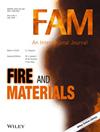Experimental Investigation of Standardized Conditioning and Representative Accelerated Drying Protocols Impact on Concrete Spalling
Abstract
Concrete spalling is a thermo-mechanical instability induced by fire exposure that needs to be investigated when the fire behavior of specific structures is to be assessed. In Europe, experimental fire behavior is commonly assessed by reference to EN 1363-1 “Fire resistance tests – Part 1: General requirements.” According to this standard, conditioning at 23°C, 50% RH for at least 3 months should be applied for concrete elements but it is also specified that at the time of the test the strength and the moisture content of the test specimen shall approximate to those expected in normal service and the test specimen shall preferably not be tested until it has reached an equilibrium moisture content resulting from storage in an ambient atmosphere of 50% relative humidity at 23°C. In this context, the main objective of this work is to study the impact of drying duration and conditions on (i) the spalling profiles of different concrete and (ii) the associated moisture profiles. An accelerated drying protocol is proposed based on an extensive experimental campaign and a numerical drying kinetics study on two high-performance concretes, and two ordinary concretes. The accelerated drying protocol aims (i) to propose a protocol allowing to reproduce of the hydric state of concrete structures in service condition (2 years) while ensuring the reproducibility of the spalling facies and secondarily (ii) to explore the possibility to reduce the conditioning time usually used in standard conditions (3 months) while maintaining acceptable representativity. The fire behavior of mechanically loaded and non-loaded slabs was evaluated at various times and conditioning modes. The important influence of the moisture gradient and the moisture content on spalling are highlighted. A good representativity of the proposed accelerated drying protocol is also observed.

 求助内容:
求助内容: 应助结果提醒方式:
应助结果提醒方式:


